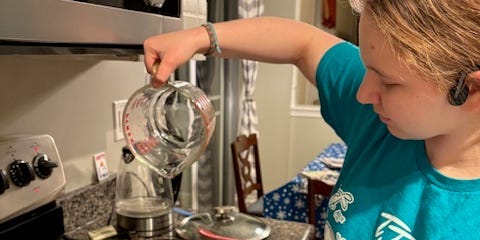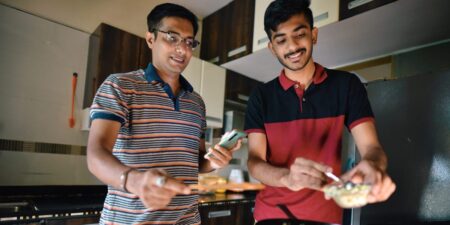Like many families, ours finds there often isn’t enough time for everything — especially time to hang out with each other in between school, work, activities and other responsibilities.
In my family, cooking is one way we work around that.
Sometimes I cook, sometimes my husband cooks, and sometimes one or both of our kids makes dinner. Not only has it helped everyone learn useful life skills, it has given us much to talk about — whether it’s seasonality of produce, the rising costs of some ingredients, or how to read nutrition labels.
My husband and I helped in the kitchen as kids
I know this isn’t a novel approach; we know many families where kids are engaged in meal planning and prep, and there are plenty of kids’ cooking classes, camps, and resources available online. For our family, we’ve enjoyed cooking this way for years and trying myriad types of foods — and it doesn’t surprise us that studies back up the idea that engaging children in cooking is linked to improvements in their dietary habits.
My husband and I relate to this from when we were growing up. We were each responsible for cooking family dinners from time to time starting in grade school due to our parents being busy with work or graduate school. Talking about it now, I think we both gained confidence, a sense of responsibility, and some solid skills. We were proud of what we accomplished — even when the recipe didn’t quite turn out as expected — and we felt prepared for when we’d be out of the house and would need to feed ourselves.
When we had kids, we wanted to teach them some of those lessons. Among the tools we used were kid-sized utensils, plastic plates and bowls, and “Pretend Soup,” one of chef-author Mollie Katzen’s cookbooks for children. I spoke with her years ago for a short vignette I was writing, and she explained how to make food accessible to young kids. That could mean putting ingredients on a surface at kid level where they can easily see them or engaging them in basic skills like mixing, using extra-large bowls until they get comfortable with it. It helps them feel useful and engaged with the process, she told me, and we found that to be true in our home.
They’ve taken over cooking
The foundation we provided at home, plus skills gleaned at Scout camping trips, cooking camps or informal “Chopped”-style contests over school breaks, gave my kids enough interest and know-how to want to help — and then take over — some of our dinner prep and cooking.
Grilled cheese, scrambled eggs, and simple salads were among their early dishes; now that they are teens, they often assign each other a cookbook to pick a recipe from each week. Sometimes it’s a tried-and-true Betty Crocker cookbook, and other times it’s a tome from chef and humanitarian José Andrés. Some recent meals they’ve made include turkey bolognese, spiced catfish sandwiches with Haitian pickled slaw, and gado gado — a traditional Indonesian salad that I’d never heard of until our son prepared and served it recently.
The kids are responsible for picking a recipe, adding ingredients we need to our shared grocery list app, choosing the day they’ll cook, and then making it happen — with at least one adult nearby to answer questions, assist with large-blade appliances, or act as a sous chef when needed.
We adapt recipes to our tastes
No one in our house tends to follow recipes to the letter when they cook; I don’t eat much meat so we often use a different protein in place of whatever the recipe lists. Our versions generally work — but my son tested that when he didn’t know where to find white wine and used white wine vinegar instead. It gave the gnocchi soup he was making a little extra zing. And the pad thai that my daughter made one weeknight took well more than an hour even with time-saving modifications, so bedtimes were rapidly approaching as we sat down to dinner.
That pad thai recipe is one I’ve never tried to make, and getting to enjoy the resulting noodle dish illustrates one of the great benefits of having multiple chefs in the house. The kids appear undaunted by ingredients or preparation tasks. I skip some recipes because they look time consuming or use a lot of dishes, but my kids are willing to try those. We’ve enjoyed homemade pasta, sushi, soft pretzels, and filled croissants because they were interested in making those things and we knew we’d all be OK however they turned out. (And we always have peanut butter in the pantry in case of a culinary emergency.)
Other benefits for my husband and me include having time to finish up work meetings or do other things while dinner is being made, knowing that we’re giving the kids time and space to contribute to the household in a way that they enjoy, and providing a springboard for discussions about bioengineered foods and buying locally.
In the gado gado recipe, which came from Katzen’s well-known Moosewood Cookbook, she notes toward the top: “HAVE FUN WITH THIS!” And my kids do.
Read the full article here
















